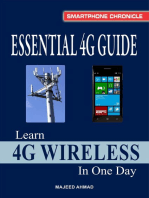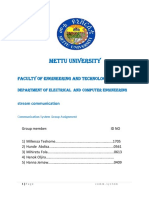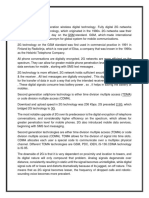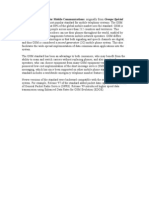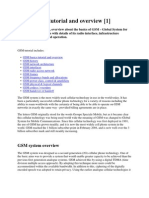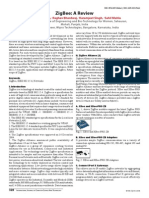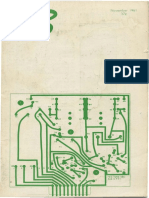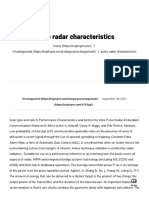GSM (Global System For Mobile Communications)
GSM (Global System For Mobile Communications)
Uploaded by
vedhajuvalCopyright:
Available Formats
GSM (Global System For Mobile Communications)
GSM (Global System For Mobile Communications)
Uploaded by
vedhajuvalOriginal Description:
Original Title
Copyright
Available Formats
Share this document
Did you find this document useful?
Is this content inappropriate?
Copyright:
Available Formats
GSM (Global System For Mobile Communications)
GSM (Global System For Mobile Communications)
Uploaded by
vedhajuvalCopyright:
Available Formats
GSM (Global System for Mobile communications)
GSM (Global System for Mobile communications) is the technology that underpins most of the world's mobile phone networks. The GSM platform is a hugely successful wireless technology and an unprecedented story of global achievement and cooperation. GSM has become the world's fastest growing communications technology of all time and the leading global mobile standard, spanning 210 countries. Today, GSM technology is in use by more than one in five of the world's population by mid-March 2006 there were over 1.7 billion GSM subscribers, representing approximately 77% of the world's cellular market. The growth of GSM continues unabated with almost 400 million new customers in the last 12 months. The progress hasn't stopped there. Today's GSM platform is living, growing and evolving and already offers an expanded and feature-rich 'family' of voice and multimedia services.
Fig.18.1. GSM Network
GSM is an open, digital cellular technology used for transmitting mobile voice and data services. GSM differs from first generation wireless systems in that it uses digital technology and time division multiple access transmission methods. GSM is a circuit-switched system that divides each 200kHz channel into eight 25kHz time-slots. GSM operates in the 900MHz and 1.8GHz bands in Europe and the 1.9GHz PCS band in the US. GSM allowing the transmission of basic data services such as SMS (Short Message Service). Another major benefit is its
international roaming capability, allowing users to access the same services when traveling abroad as at home. This gives consumers seamless and same number connectivity in more than 200 countries. GSM satellite roaming has also extended service access to areas where terrestrial coverage is not available.
GSM Specifications Frequency 900 MHz or 1800 MHz (Some countries in the Americas including Canada and the United States use the 850 MHz and 1900 MHz bands, 400 and 450 MHz frequency bands are assigned in some countries, notably Scandinavia) Channel separation - The separation between adjacent carrier frequencies. In GSM, this is 200 kHz. Modulation - Gaussian minimum shift keying (GMSK). Transmission rate - 270 kbps. (A total of 156.25 bits is transmitted in 0.577 milliseconds, giving a gross bit rate of 270.833 kbps) Access method - Time Division Multiple Access (TDMA) concept Speech coder - Linear predictive coding (LPC). Speech is encoded at 13 kbps.
Frequency Reuse Frequency reuse is based on assigning to each cell a group of radio channels used within a small geographic area. Cells are assigned a group of channels that is completely different from neighboring cells. The coverage area of cells is called the footprint. This footprint is limited by a boundary so that the same group of channels can be used in different cells that are far enough away from each other so that their frequencies do not interfere. The number of available frequencies is 7; the frequency reuse factor is 1/7.
Fig.18.2. Frequency Reuse
TDMA Vs CDMA
In todays world cell phone has become the single greatest tool in day today life. It has become a necessity that business associates should be able to communicate on the go. An important question when designing and standardizing cellular systems is the selection of the multiple access schemes. There are three basic principles in multiple access, FDMA (Frequency Division Multiple Access), TDMA (Time Division Multiple Access), and CDMA (Code Division Multiple Access). All three principles allow multiple users to share the same physical channel. But the two competing technologies differ in the way user sharing the common resource. TDMA allows the users to share the same frequency channel by dividing the signal into different time slots. Each user takes turn in a round robin fashion for transmitting and receiving over the channel. CDMA uses a spread spectrum technology that is it spreads the information contained in a particular signal of interest over a much greater bandwidth than the original signal. In TDMA users can only transmit in their respective time slot. Unlike TDMA, in CDMA several users can transmit over the channel at the same time. TDMA stands for "Time Division Multiple Access", while CDMA stands for "Code Division Multiple Access". Three of the four words in each acronym are identical, since each technology essentially achieves the same goal, but by using different methods. Each strives to better utilize the radio spectrum by allowing multiple users to share the same physical channel. More than one person can carry on a conversation on the same frequency without causing interference. This is the magic of digital technology. Where the two competing technologies differ is in the manner in which users share the common resource. TDMA does it by chopping up the channel into sequential time slices. Each user of the channel takes turns transmitting and receiving in a round-robin fashion. In reality, only one person is actually using the channel at any given moment, but he or she only uses it for short bursts. He then gives up the channel momentarily to allow the other users to have their turn. This is very similar to how a computer with just one processor can seem to run multiple applications simultaneously.
Fig.18.3. TDMA
CDMA on the hand really does let everyone transmit at the same time. Conventional wisdom would lead you to believe that this is simply not possible. Using conventional modulation techniques, it most certainly is impossible. What makes CDMA work is a special
type of digital modulation called "Spread Spectrum". This form of modulation takes the user's stream of bits and splatters them across a very wide channel in a pseudo-random fashion. The "pseudo" part is very important here, since the receiver must be able to undo the randomization in order to collect the bits together in a coherent order.
Fig.18.4. CDMA
You might also like
- Goc Marina Reviewer PDFDocument57 pagesGoc Marina Reviewer PDFAl Jhem Geronimo67% (6)
- Berry - 1963 - The Reflectarray AntennaDocument7 pagesBerry - 1963 - The Reflectarray Antennaanthony greavesNo ratings yet
- Essential 4G Guide: Learn 4G Wireless In One DayFrom EverandEssential 4G Guide: Learn 4G Wireless In One DayRating: 4.5 out of 5 stars4.5/5 (12)
- Chapter 9 Shadowing SaundersDocument21 pagesChapter 9 Shadowing SaundersChuxy UdNo ratings yet
- Wireles Solution ExercisesDocument22 pagesWireles Solution ExercisesUmair Islam100% (2)
- Microwave Theory and TechniquesDocument7 pagesMicrowave Theory and TechniquesSudip MondalNo ratings yet
- CD MaDocument28 pagesCD MaParminder SinghNo ratings yet
- Mobile Computing Unit IIDocument28 pagesMobile Computing Unit IIAkash ShuklaNo ratings yet
- Access Methods For Mobile Networks - ShavaneDocument2 pagesAccess Methods For Mobile Networks - ShavaneDrumz Staff50% (2)
- WMC Practical FileDocument25 pagesWMC Practical FileDilpalNo ratings yet
- Name: Kaydian Johnson MIS Yr 1/ STR 2Document6 pagesName: Kaydian Johnson MIS Yr 1/ STR 2clintionNo ratings yet
- 2G Cellular SystemsDocument5 pages2G Cellular SystemsVanagara BharatNo ratings yet
- CDMA ADocument17 pagesCDMA ATejbinder SinghNo ratings yet
- Term Paper On CDMADocument5 pagesTerm Paper On CDMATaufeeq Malik100% (1)
- Mobile CommunicationDocument40 pagesMobile Communicationrahul_643No ratings yet
- Industrial Training Report On CDMA TechnologyDocument9 pagesIndustrial Training Report On CDMA TechnologyDeepakGujraniya100% (6)
- GSM NotesDocument17 pagesGSM NotesAbhishek KushwahaNo ratings yet
- A Project Report On Cdma TechnologyDocument102 pagesA Project Report On Cdma Technologyanujag007100% (2)
- Assignment 4 - MultiplexingDocument16 pagesAssignment 4 - MultiplexingEugene Embalzado Jr.No ratings yet
- Development of Mobile Communications: Cellular Radio OperationDocument10 pagesDevelopment of Mobile Communications: Cellular Radio OperationgahilarNo ratings yet
- Multiple Input-Multiple Output Ofdm SystemsDocument36 pagesMultiple Input-Multiple Output Ofdm SystemsLoukya KuttiNo ratings yet
- CDMADocument38 pagesCDMAneerNo ratings yet
- Cdma:: Code Division Multiple Access (CDMA) Is A Channel Access Method Used byDocument10 pagesCdma:: Code Division Multiple Access (CDMA) Is A Channel Access Method Used bySRL MECHNo ratings yet
- Computer Networks Assignment-2: Topic-Working of Physical Layer in 1G, 2G, 3G and 4G NetworksDocument12 pagesComputer Networks Assignment-2: Topic-Working of Physical Layer in 1G, 2G, 3G and 4G NetworksPunit KyalNo ratings yet
- Wireless Mobile CommunicationDocument6 pagesWireless Mobile Communicationduyttcute1989No ratings yet
- ReportDocument28 pagesReportSHAIK CHAND PASHANo ratings yet
- Group 2Document12 pagesGroup 2Tolu AyanaNo ratings yet
- EC803 Unit I Notes - 1708339717Document23 pagesEC803 Unit I Notes - 1708339717Mine InstrumentsNo ratings yet
- Multiple Access Techniques (CDMA, TDMA, FDMA) : Reported byDocument7 pagesMultiple Access Techniques (CDMA, TDMA, FDMA) : Reported byXzxz WahshNo ratings yet
- CD MaDocument8 pagesCD MaDheeraj BahadurNo ratings yet
- Time Division Multiple Access - TDMADocument13 pagesTime Division Multiple Access - TDMATaher AymanNo ratings yet
- CDMADocument10 pagesCDMAjagadeesh jagadeNo ratings yet
- Limitations of CDMADocument8 pagesLimitations of CDMAsantoshnemadeNo ratings yet
- M-Commerce Unit-3Document7 pagesM-Commerce Unit-3nithashaindrojuNo ratings yet
- Mobile Computing ReportDocument21 pagesMobile Computing Reportakshata_pinks3No ratings yet
- GPRS, GSM, CdmaDocument3 pagesGPRS, GSM, CdmaDulce DeNo ratings yet
- State of The Art of Modulation Techniques Being Used in Various Communication TechnologiesDocument5 pagesState of The Art of Modulation Techniques Being Used in Various Communication TechnologiesSabbir AhmedNo ratings yet
- Frequency Reuse: Channel Access MethodDocument6 pagesFrequency Reuse: Channel Access MethodBassy KaserNo ratings yet
- Information About CDMADocument8 pagesInformation About CDMANishabh ShuklaNo ratings yet
- What Is 2G?Document19 pagesWhat Is 2G?Haya MalikNo ratings yet
- Mobile Comm Lec 7Document38 pagesMobile Comm Lec 7Ehtesham UddinNo ratings yet
- Cdma Technology Seminar ReportDocument24 pagesCdma Technology Seminar ReportPriya DixitNo ratings yet
- Code Division Multiple Access (CDMA) : Supervised By: DR - Redhwan Qasem ShaddadDocument7 pagesCode Division Multiple Access (CDMA) : Supervised By: DR - Redhwan Qasem Shaddadabdulaziz saif ali mansoorNo ratings yet
- Comp 3GDocument42 pagesComp 3GW.D.P.C PereraNo ratings yet
- Term Paper OF: Global System For Mobile Communication (GSM)Document18 pagesTerm Paper OF: Global System For Mobile Communication (GSM)amitmaheshpurNo ratings yet
- wireless assignmentDocument7 pageswireless assignmentBadasa GalchuNo ratings yet
- A Seminar Report ON: Cdma TechnologyDocument25 pagesA Seminar Report ON: Cdma TechnologyAnkur BansalNo ratings yet
- Technical DetailsDocument6 pagesTechnical DetailsShamim AhmedNo ratings yet
- Prepared by Kartikeya Tiwari. 0817EC081030Document20 pagesPrepared by Kartikeya Tiwari. 0817EC081030Sonu TiwariNo ratings yet
- Adaptive Active Constellation Extension Algorithm For Peak-To-Average Ratio Reduction in OfdmDocument11 pagesAdaptive Active Constellation Extension Algorithm For Peak-To-Average Ratio Reduction in Ofdmsurendiran123No ratings yet
- Mobile) Is The World's Most Popular Standard For Mobile Telephony Systems. The GSMDocument3 pagesMobile) Is The World's Most Popular Standard For Mobile Telephony Systems. The GSMDhanvantari Rao JalagamNo ratings yet
- Overview of Modern Wireless Communication SystemsDocument58 pagesOverview of Modern Wireless Communication SystemsMani SandhuNo ratings yet
- Mobile), Is A Standard Set Developed by The ETSI (European TelecommunicationsDocument1 pageMobile), Is A Standard Set Developed by The ETSI (European TelecommunicationsSaeed AalamNo ratings yet
- Cdma Deepak Final 1Document83 pagesCdma Deepak Final 1deepak18mNo ratings yet
- WC CHAPTER 5.pdf-1684302485631Document11 pagesWC CHAPTER 5.pdf-1684302485631manjuNo ratings yet
- Tale of A Two Networks: Roaming, (4) Ability To Support Handheld TerminalsDocument6 pagesTale of A Two Networks: Roaming, (4) Ability To Support Handheld TerminalsARVINDNo ratings yet
- Comparative Study of GSM, CDMA, 2G, 3G and 4 G Methods What Is GSM?Document14 pagesComparative Study of GSM, CDMA, 2G, 3G and 4 G Methods What Is GSM?Clean 91No ratings yet
- CDMA Quick GuideDocument29 pagesCDMA Quick GuideHashem AllahamNo ratings yet
- GSM Vs CDMA Vs TDMADocument3 pagesGSM Vs CDMA Vs TDMAMohak BhatiaNo ratings yet
- GSM Basics Tutorial and OverviewDocument60 pagesGSM Basics Tutorial and OverviewTariq KhurshaidiNo ratings yet
- Multiple Access TechniquesDocument6 pagesMultiple Access TechniquesAwais ShoukatNo ratings yet
- Complete Project ReportDocument92 pagesComplete Project ReportNOIC12No ratings yet
- Code Division Multiple AccessDocument2 pagesCode Division Multiple AccessArindam MukherjeeNo ratings yet
- Applications of GSM ModemDocument4 pagesApplications of GSM ModemvedhajuvalNo ratings yet
- Applications of GSM ModemDocument4 pagesApplications of GSM ModemvedhajuvalNo ratings yet
- Embedded ARM11Document195 pagesEmbedded ARM11vedhajuval100% (1)
- Production FunctionDocument16 pagesProduction FunctionvedhajuvalNo ratings yet
- Organisation Behavior Group ProcessDocument11 pagesOrganisation Behavior Group ProcessvedhajuvalNo ratings yet
- ChristmasDocument21 pagesChristmasvedhajuvalNo ratings yet
- France: - Christmas Traditions & CustomsDocument3 pagesFrance: - Christmas Traditions & CustomsvedhajuvalNo ratings yet
- GSM Specification:: Vi Microsystems PVT LTD, Chennai-96Document1 pageGSM Specification:: Vi Microsystems PVT LTD, Chennai-96vedhajuvalNo ratings yet
- Uyir Theeyin JothiDocument81 pagesUyir Theeyin JothiVinothini SelvarajNo ratings yet
- 2148 CircuitDocument4 pages2148 CircuitvedhajuvalNo ratings yet
- Difference Between Microprocessor and MicrocontrollerDocument17 pagesDifference Between Microprocessor and MicrocontrollervedhajuvalNo ratings yet
- CW GuideDocument25 pagesCW Guidebisti tuNo ratings yet
- 4-Chapter - 4 Transmission MediaDocument22 pages4-Chapter - 4 Transmission MediaasifazareenNo ratings yet
- Central Hacker For Hire Wifi HackingDocument4 pagesCentral Hacker For Hire Wifi HackingTechbinNo ratings yet
- 70 CM DuplexerDocument7 pages70 CM DuplexerEdgardo Valdez100% (1)
- Zigbee: A Review: Gurpreet Singh, Raghav Bhardwaj, Karamjeet Singh, Sahil MehlaDocument4 pagesZigbee: A Review: Gurpreet Singh, Raghav Bhardwaj, Karamjeet Singh, Sahil MehlaEs LimNo ratings yet
- Troubleshooting For IDAS Multi-Site TrunkingDocument33 pagesTroubleshooting For IDAS Multi-Site TrunkinglaboratoriosiscomNo ratings yet
- EST Problem Set 3 Answer KeyDocument4 pagesEST Problem Set 3 Answer KeyJhunxz FirmalinoNo ratings yet
- Thales MbitrDocument4 pagesThales Mbitrtzimistigris100% (1)
- 1 5002033 PDFDocument9 pages1 5002033 PDFDmk ChaitanyaNo ratings yet
- Vikram - QA Enginner - LTE-IMS-Testing PDFDocument5 pagesVikram - QA Enginner - LTE-IMS-Testing PDFYATENDRA TRIPATHINo ratings yet
- (IJCST-V4I2P61) :akshika Aneja, Garima SodhiDocument4 pages(IJCST-V4I2P61) :akshika Aneja, Garima SodhiEighthSenseGroupNo ratings yet
- RF Planning BasicsDocument14 pagesRF Planning BasicsRakesh SolankiNo ratings yet
- Xxpol 1710 2170Mhz 65 ° 17.8dbi Adjustable Electrical Downtilt Antenna, Manual or by Optional Rcu (Remote Control Unit)Document1 pageXxpol 1710 2170Mhz 65 ° 17.8dbi Adjustable Electrical Downtilt Antenna, Manual or by Optional Rcu (Remote Control Unit)АлександрNo ratings yet
- 5G RAN RFI - Telefonica Global - Ericsson Presentation V6Document115 pages5G RAN RFI - Telefonica Global - Ericsson Presentation V6multitrabajos.fzNo ratings yet
- Wireless Lecture 1Document70 pagesWireless Lecture 1yimammohammed188No ratings yet
- Cracking We P and Wpa Wireless NetworksDocument18 pagesCracking We P and Wpa Wireless NetworksBasic204No ratings yet
- 73 Magazine 1961 11 November PDFDocument92 pages73 Magazine 1961 11 November PDFCatalin ZestranNo ratings yet
- Friis Transmission Equation CalculatorDocument20 pagesFriis Transmission Equation CalculatorMohamed Zied ChaariNo ratings yet
- Frequency Reuse: Channel Access MethodDocument6 pagesFrequency Reuse: Channel Access MethodBassy KaserNo ratings yet
- DVB T FactsheetDocument2 pagesDVB T Factsheetgossananicet9915No ratings yet
- GSM General Questions and Answers & Some Practical KnowledgeDocument11 pagesGSM General Questions and Answers & Some Practical Knowledgealonind100% (1)
- Google LoonDocument34 pagesGoogle LoonHoney SinghNo ratings yet
- Pulse Radar CharacteristicsDocument15 pagesPulse Radar CharacteristicsBRIGHT TZZZY CHINGWENANo ratings yet
- Picture 1. Basic Network Architecture For An SMS Deployment (IS-41)Document15 pagesPicture 1. Basic Network Architecture For An SMS Deployment (IS-41)riadelectroNo ratings yet
- CPE Series-DatasheetDocument13 pagesCPE Series-Datasheetvtds1975100% (1)


